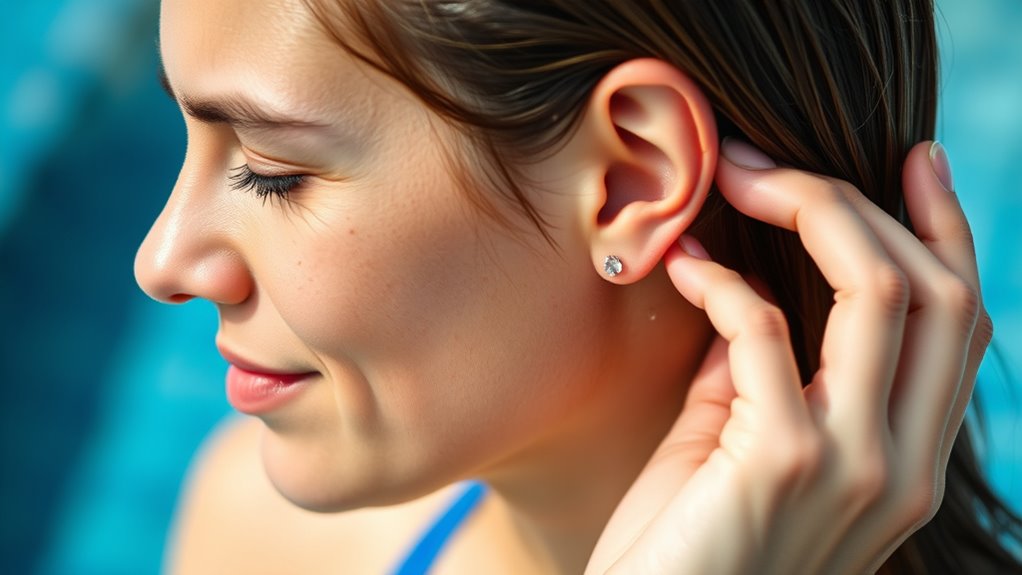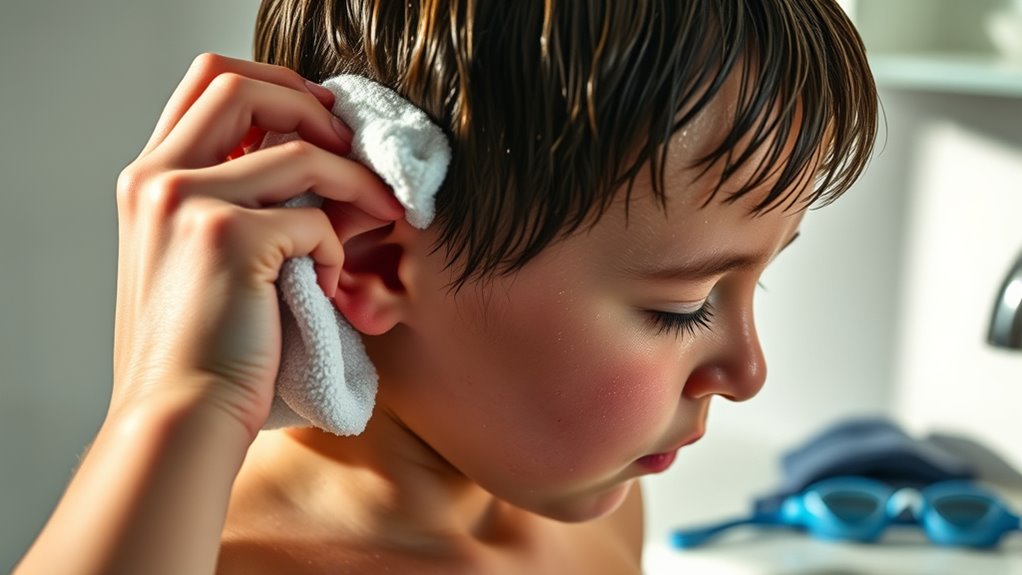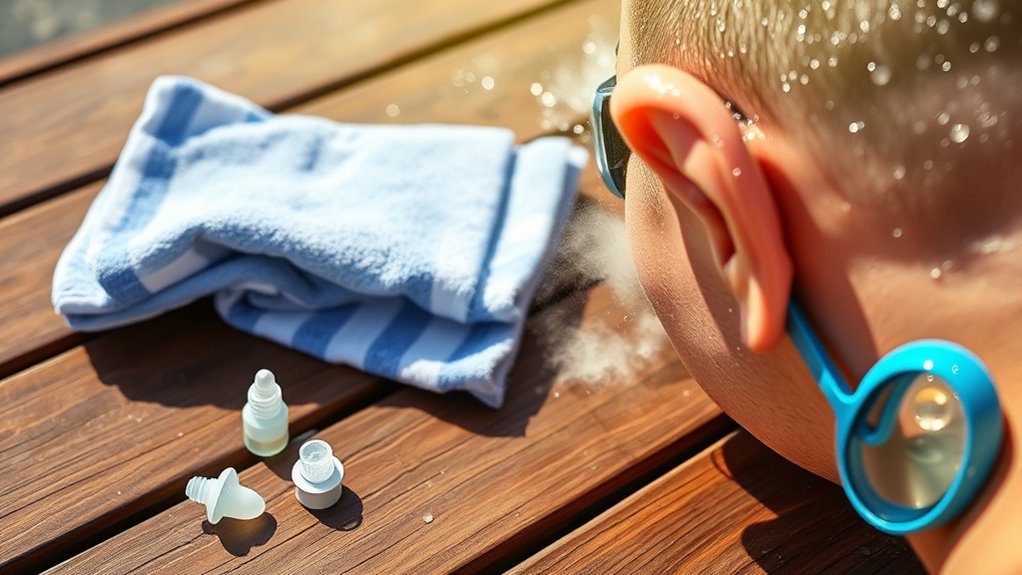Five proven techniques to relieve post-swimming ear pain include the gentle tilt and drain method to utilize gravity for water removal, alcohol-based ear drops to evaporate moisture and prevent bacterial growth, warm compress application to reduce inflammation, professional microsuction for stubborn blockages, and preventative measures like quality earplugs for future swims. Each technique offers varying levels of intervention depending on your discomfort severity and condition persistence. Investigate these methods for thorough relief from swimmer’s ear discomfort.
The Gentle Tilt and Drain Method

When fluid accumulates in your ear canal due to infection or water exposure, the Gentle Tilt and Drain Method offers an effective primary intervention. This technique utilizes gravity to facilitate fluid evacuation through a simple positioning process.
To perform the tilt technique, tilt your head sideways with the affected ear parallel to the floor. Gently pull your earlobe outward and backward to straighten the ear canal. Maintain this position for 30-60 seconds while the drainage process occurs naturally. You’ll often feel a subtle sensation as trapped water begins to escape.
For improved results, you can alternate between tilting and gently tapping the opposite side of your head. Don’t insert any objects into your ear during this procedure. If pain persists beyond 24 hours or worsens despite drainage attempts, consult a healthcare professional immediately.
Using Alcohol-Based Ear Drops
While the tilt and drain method effectively removes accumulated fluid, alcohol-based ear drops provide another valuable approach for addressing ear pain. These solutions work by evaporating residual water and creating an environment that inhibits bacterial growth.
| Product Type | Alcohol Concentration | Ear Drop Effectiveness |
|---|---|---|
| Commercial drops | 95% isopropyl | High efficacy, rapid drying |
| DIY solution | 70% isopropyl/white vinegar | Moderate efficacy, economical |
| Prescription formulas | 70-95% with medications | Highest efficacy, treats infection |
| Pediatric formula | 70% with glycerin | Gentle, lower irritation potential |
You’ll achieve ideal results by applying 3-5 drops in the affected ear while lying on your side for 30 seconds. Repeat twice daily until symptoms resolve. The higher alcohol concentration typically correlates with faster drying time but may cause increased irritation in sensitive individuals.
Warm Compress Application for Pain Relief

Three effective warm compress techniques can provide immediate relief for ear pain when medication isn’t readily available. The application of controlled heat therapy effectiveness reduces inflammation, improves circulation, and relaxes tense muscles around the ear canal.
Controlled heat therapy offers natural, instant relief for ear discomfort through inflammation reduction and improved blood flow.
- Dampen a clean washcloth with warm water (not hot), wring out excess moisture, and apply gently to the affected ear for 10-15 minutes.
- Use a specially designed warm compress ear pillow that maintains consistent temperature for ideal warm compress benefits.
- Create a homemade rice pack by filling a clean sock with uncooked rice, heating it in the microwave for 30 seconds, and applying it to your ear.
Always test temperature before application to prevent burns, and discontinue if pain worsens during treatment.
Professional Ear Suction Techniques
Professional ear suction techniques represent a specialized medical intervention for removing stubborn blockages that home remedies can’t address. When water becomes trapped behind significant earwax buildup, an ENT specialist or audiologist may perform microsuction—a precision procedure using specialized suction devices under microscopic visualization.
During the procedure, you’ll sit with your head tilted while the practitioner uses a thin, sterile cannula to create gentle vacuum pressure. This targeted earwax removal technique extracts both the impacted debris and trapped water without pushing material deeper into the ear canal.
Unlike home irrigation methods, professional suction eliminates the risk of eardrum perforation and provides immediate relief from pain and pressure. It’s particularly recommended if you’re experiencing severe discomfort, hearing loss, or if you have a history of ear conditions.
Preventative Measures for Future Swims

To prevent water-related ear pain after swimming, you’ll need to implement several protective strategies before entering the water. The development of proper preventative habits greatly reduces your risk of swimmer’s ear and associated discomfort.
- Invest in high-quality silicone or custom-molded earplugs; benefits include creating a watertight seal that prevents water from entering the ear canal while maintaining comfort during extended swim sessions.
- Modify your swimming techniques by keeping your head above water when possible, and tilting your head to allow natural drainage after submersion.
- Apply a preventative ear drop solution containing a mixture of one part white vinegar to one part rubbing alcohol before and after swimming to maintain proper pH and discourage bacterial growth.
Always thoroughly dry your outer ears with a towel after swimming, followed by gentle tilting to drain trapped water.
Frequently Asked Questions
How Long Does Swimmer’s Ear Typically Last Without Treatment?
Without treatment, swimmer’s ear typically lasts 1-2 weeks. You’ll experience progressive symptoms including itching, redness, pain, and possibly discharge. During this swimmer’s ear duration, your discomfort may intensify before gradually resolving as your body fights the infection. Pain management is challenging without intervention, as the inflammation can worsen before improving. Medical treatment greatly reduces recovery time to 3-7 days and prevents potential complications like temporary hearing loss or spread of infection.
Can Children Use the Same Ear Pain Remedies as Adults?
Children can use many of the same ear pain remedies as adults, but with notable modifications. You’ll need to adjust medication dosages based on your child’s weight and stage of development. Children’s remedies should avoid alcohol-based ear drops, which may be too harsh for their sensitive ear canals. Adult differences include concentration strength and application methods. Always consult a pediatrician before treating swimmer’s ear in children, as their ear anatomy differs markedly from adults, requiring more careful treatment approaches.
Are There Any Over-The-Counter Medications That Relieve Swimmer’s Ear Pain?
Yes, you can find several over-the-counter options for swimmer’s ear pain relief. Look for specialized ear drops containing benzocaine or similar anesthetics that temporarily numb the area. Acetic acid drops help restore proper pH and fight infection. NSAIDs like ibuprofen or acetaminophen can reduce inflammation and pain. Always guarantee your ear canal is dry before application. If symptoms persist beyond 48 hours or worsen, discontinue self-treatment and consult a healthcare provider immediately.
When Should I See a Doctor About Swimming-Related Ear Pain?
You should see a doctor about swimming-related ear pain if symptoms persist longer than 3-5 days despite home treatment, or immediately if you experience severe pain, complete hearing loss, fever, or drainage from the ear. Prompt symptom evaluation by a healthcare provider guarantees proper diagnosis and appropriate treatment options, which may include prescription-strength medications or professional cleaning. Don’t delay medical attention if pain worsens or is accompanied by dizziness, as untreated ear infections can lead to complications.
Can Ear Pain After Swimming Indicate a More Serious Condition?
Yes, ear pain after swimming can indicate a more serious condition like swimmer’s ear or a middle ear infection. Watch for these symptoms checklist items: pain that worsens when touching your ear, discharge, muffled hearing, fever, or swelling. If you’re experiencing persistent pain lasting more than 2-3 days, increasing intensity, or symptoms that don’t respond to home treatments, you should consult a healthcare provider immediately for proper diagnosis and treatment.



